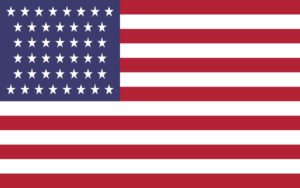
In 1893, the U.S. flag sported forty-four stars for the forty-four states of the union.
Flag Day marks the anniversary of adoption of the United States flag on June 14, 1777. An official holiday (though not a federal holiday) since 1946, Flag Day commemorations emerged in the 1880s. Apparently there were no Flag Day observances at the 1893 World’s Columbian Exposition on June 14, though.
In honor of “Old Glory,” we offer this article from the November 1893 issue of World’s Columbian Exposition Illustrated, describing one interesting and significant U.S. flag that appeared in several 1893 World’s Fair events and attractions.
The “New Liberty Bell” mentioned in this articles was also called the “Columbian Bell” and stood on the west side of the Administration Building.
AMERICA’S STANDARD FLAG.
One of the first agitators of the World’s Fair project, and the first to start and call a meeting in behalf of the mining interests of the country, on Tuesday, August 20th, 1889, and of which he was appointed chairman, was George Simeon Knapp. Representing the mining interests he went to Washington with the delegates, continuing his efforts in its behalf until the 24th day of February, 1890, at six o’clock P.M., in the House of Representatives he unfurled the first American flag in honor of Chicago and the World’s Fair. It was then he conceived the idea that a flag with a staff composed of historic woods, the woods to be furnished by the commissioners from the different states of the union, should be dedicated to the World’s Columbian Exposition, to be preserved as a relic of this wondrous undertaking; and upon further consideration, on April 4, 1891, submitted a communication addressed to the World’s Columbian Commission, setting forth the proposition to present such a flag to the Board of Lady Commissioners, who would join with their Honorable Body at the close of the Exposition it presenting it, with the staff, to the United States as a lasting memorial of the great occasion, and that it should be carried at the head of the dedicatory procession to Jackson Park in October, 1892.
Mr. Knapp and son gave an order to the Woman’s Silk Culture Association of the United States, at Philadelphia, to make for them a flag from silk produced and manufactured solely in this country. The result met the most sanguine expectations. The silk was grown in twenty-five states of our union: Alabama, Connecticut, Delaware, Dakota, Florida, Indiana, Illinois, Iowa, Kansas, Kentucky, Massachusetts, Michigan, Missouri, Maryland, Nebraska, New York, North Carolina, New Jersey, Ohio, Pennsylvania, South Carolina, Texas, Virginia, West Virginia and Wisconsin; it was reeled, thrown, dyed, woven and made by the association at Philadelphia, the birthplace of the first American flag.
The flag was given the leading place at the head of the procession on October 21, 1892, carried in a carriage by Mr. Knapp and his son, Geo. M. Knapp, it being recognized as the standard flag of America and the World’s Columbian Exposition, and saluted as such. They also had the honor of accompanying the “Old Liberty Bell” with the flag, on its transit through the city to the Pennsylvania State building, at Jackson Park, April 29, 1893.
On May 1, 1893, at the opening exercises of the Woman’s building, it took a prominent part. It was also given the place of honor in receiving the Paul Jones’ flag, and Flag of Human Freedom, on July 4th, 1893, when they were raised and unfurled at the ringing of the “New Liberty Bell.” And thereafter the three flags lovingly enfolded the “Old Liberty Bell” at the Pennsylvania State building, that silent messenger which will ever “Proclaim liberty through all the land to all the inhabitants thereof.”
Mr. Knapp was born in Sterling, Cayuga county, New York, March 10, 1840. In 1845 his parents removed to Wisconsin. In 1860 he removed to Dubuque, Iowa, and in 1865 to Winona, Minn. Since 1870 he has been a resident of Chicago, which he has helped to raise from the ashes of the great fire. Mr. Knapp is a member of the “Sons of New York,” the “Old Tippecanoe Club” and the historical society, and has always been interested in the antique, having the largest collection of curiosities in the west.
